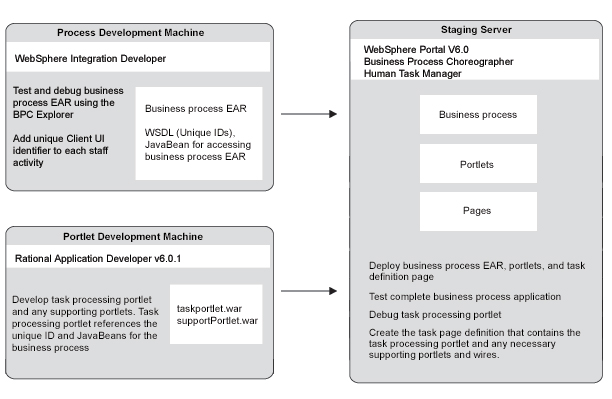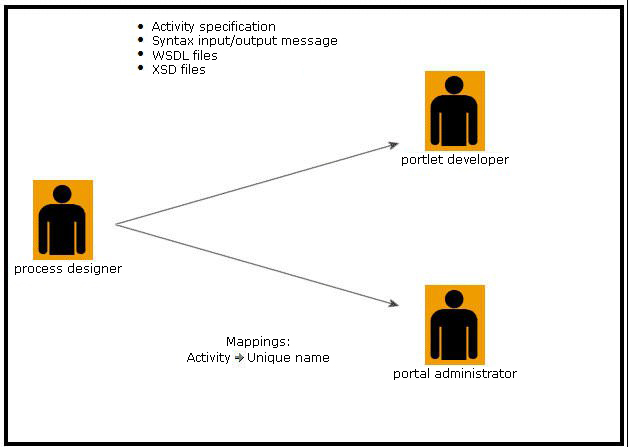Set up the development environment for process applications
Software
The following software is used to develop business process applications for WebSphere Portal.
- Rational Application Developer
Provides wizards and tools for developing task processing portlets.
- WebSphere Integration Developer
Provides...
- BPEL process editor
- WebSphere runtime test environment
- WebSphere Portal and Business Process Choreographer
Provides a runtime environment for testing all of the business process components.
The following configuration is provided by the default WebSphere Portal installation...
- WebSphere Portal and Business Process Choreographer is configured to the application server...
WebSphere_Portal
- WebSphere Platform Messaging is provided by WebSphere Application Server.
- The Human Task Manager application is deployed.
- The property...
HumanTaskManagerJNDIName...in ConfigService.properties indicates the jndi name of the HumanTaskManager ejb.
In some circumstances you might need to manually configure the business process container for WebSphere Portal.
Development roles
Business process development for WebSphere Portal can be divided into the following roles.
- Process designer:
The process designer uses WebSphere Integration Developer to create the business process, including the control and data flow, the syntax of the input and output messages, and the semantics of the single activities contained in the process. The process designer must also define a Client UI identifier for each staff activity that should be processed in portal.
- Portlet application developer:
The portlet developer uses Rational Application Developer to develop the task processing portlet, the process initiation portlet, and any other portlets used to support the business process application. This development is based on the input or output that the portlet must consume or produce.
- Portal administrator:
The portal administrator uses portal administrative tools, such as Manage Pages and Custom Unique Names, to setup the task page definition for the business process application.
In some cases, these roles can be shared by a single developer. Otherwise, information must be shared between the developers. The process designer must provide the following information/code to the portlet application developer.
- Activity specification:
The activity specification describes in detail the purpose of the activity, how the input and output messages correlate, the acceptable values for single entries in a message, and the expected results for the output message.
This specification also contains the correct syntax of the input and output messages.
- Web Services Description Language (WSDL) and XML Schema Definition (XSD) files that describe the task:
The task interface and schemas of the input and output messages are required by the portlets to access the input and output messages at runtime.
For each activity that should be processed in the portal, the process designer must provide the unique name of that activity to the portal administrator. The portal administrator must assign these unique names to the according task page definitions.
Development environment configuration
To test the complete portal-based business process application, IBM recommends to set up a staging server that can be accessed by the different developers. When the development environment is set up, the steps in this section must be performed.
When testing the components of a business process application, J2EE security must be enabled on the test portal server to correctly display the user's personal tasks.
Existing portlets that use the business process engine APIs (com.ibm.bpe.api package) to perform their own process integration will still work in WebSphere Portal . If the code should be modified or new portlets should be developed with this API, the configuration described in this section should also be used as the development and test environment. However, the business process engine APIs are not supported in task processing portlets for business process integration in WebSphere Portal. To fully integrate existing portlets that perform processing of tasks, the portlets must be rewritten using the Task API as described in Creating the task processing portlet. For portal applications which use the task processing portlets, the business process engine APIs are supported only for managing the business process instances (that is, for launching process instances or deleting them) as described in Initiating a process instance.
- The process designer develops the business process and unit tests it using the integrated test environment. During development he sets the Client UI identifier on each activity of the business process that should be processed within portal. When the process is finished, he exports the WSDL and XSD files that are required by the portlet application developer and also generates the deploy code and exports it as an EAR that he deploys on the staging server.
- The portlet application developer first imports the necessary WSDL and XSD classes from the business process. After that she starts developing the task processing portlet. She can not directly test the portlet; but must first deploy it to the staging server on a page that has the unique name defined as the Client UI Identifier of the activity. To test the portlet, the according business process must be started (using the BPC Explorer) and be processed until the appropriate activity is reached (either using the BPC Explorer or other portlets that are already created).
- The administrator can now add additional supporting portlets to the task page definition and also setup any necessary wires.

Rational Application Developer and WebSphere Integration Developer can be setup on the same machine and share the same workbench.
After all components of the business process application have been developed and successfully tested, we can deploy the components to a production server as described in Deploying the business process application.
JAR files needed by the task processing portlet
The following JARs need to be included in the runtime of the development environment to allow the task processing portlet to compile successfully.
- bpe.jar
- bpecommon.jar
- bpecore.jar
- emf.jar
- taskapi.jar
- bpe137650.jar
- task137650.jar
- wp.base.jar
- wp.pe.api.standard.jar
- wp.processintegration.jar
- jsr168-api.jar
- JAR from the process EAR containing the process messages required by the portlet
Parent topic:
Develop business process applications
Related concepts
